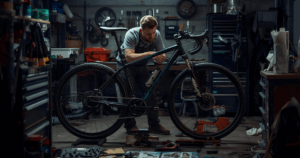Regular bike maintenance is essential for ensuring your ride remains safe, smooth, and enjoyable. Whether you’re a weekend warrior, daily commuter, or e-bike enthusiast, your bicycle undergoes constant wear and tear. Even the most reliable bikes need occasional servicing to keep them in peak condition. A tune-up not only extends the lifespan of your bicycle but also helps avoid costly repairs down the line. But how do you know when it’s time to give your bike some professional attention?
In this blog post, we’ll cover the top five signs your bike needs a tune-up, and along the way, emphasize how vital consistent bike maintenance is to the overall cycling experience. Knowing these signs will help you stay proactive and keep your two-wheeled companion in top form.
1. Your Gears Are Skipping or Not Shifting Smoothly
One of the clearest signs your bike needs a tune-up is when your gears start misbehaving. If you notice that your bike struggles to shift, skips gears mid-ride, or makes clicking sounds, it’s time to address your drivetrain.
Over time, cables stretch, and derailleurs lose alignment, causing shifts to become less accurate. Dirt, grime, and rust can also affect how smoothly your bike transitions between gears. This not only affects your ride quality but could lead to long-term damage if left unaddressed.
A comprehensive bike maintenance routine includes checking and lubricating the drivetrain, tightening gear cables, and realigning the derailleur. For e-bikes, it’s especially important since precise gear shifting affects motor performance. A tune-up will restore proper gear function and make every pedal stroke efficient again.
2. You Hear Strange Noises When Riding
Squeaks, creaks, and clunks are never good signs when it comes to cycling. These sounds may seem minor at first, but they often signal more serious underlying problems. Loose components, dry chains, untrue wheels, or worn-out bearings can all contribute to unusual bike noises.
Ignoring these noises can turn a simple fix into a major repair. For instance, a dry chain might seem harmless, but without proper lubrication, it could snap mid-ride. Similarly, a loose crank or bottom bracket can damage the bike frame over time.
Including regular checks for noise in your bike maintenance routine can help you catch these issues early. During a tune-up, a technician will identify and address the source of the noise—tightening bolts, greasing components, and adjusting parts to restore silent performance.
3. Braking Power Feels Weak or Inconsistent
Your brakes are your most important safety feature. If you find yourself pulling harder than usual on the brake levers or noticing delayed stopping, it’s time for a brake check. Soft, squeaky, or unresponsive brakes are major red flags.
Brake pads wear down with use, and cables or hydraulic systems can become less effective over time. You might even find that your rotors are warped or contaminated, especially if you’ve been riding in wet or dirty conditions.
A solid bike maintenance plan involves inspecting brake pads for wear, checking cable tension or hydraulic fluid levels, and ensuring that all components are aligned properly. A tune-up ensures your brakes respond instantly when you need them most, keeping you safe on the roads or trails.
4. The Ride Feels Rough or Unstable
Have you noticed that your ride just doesn’t feel right lately? Maybe your bike feels wobbly, bumpy, or hard to control. These symptoms often point to issues with your wheels, suspension, or frame alignment.
Untrue wheels (ones that aren’t perfectly circular) can cause vibrations, while low tire pressure or worn-out suspension forks can turn your smooth commute into a bumpy journey. In extreme cases, a bent frame or misaligned components could compromise your safety.
To avoid surprises, include tire inspection, wheel truing, and frame assessment in your bike maintenance checklist. A tune-up includes checking spoke tension, ensuring your suspension is properly set up, and verifying that your frame and fork are intact. Especially for e-bike riders, the added weight and speed can intensify these issues if ignored.
5. You’ve Ridden 1,000km+ Without Service
Even if your bike seems to be performing well, routine bike maintenance is crucial after extended use. As a rule of thumb, most bikes benefit from a professional tune-up every 1,000 to 2,000 kilometers. If you can’t remember the last time your bike saw a work stand, it’s probably overdue.
Wear and tear are inevitable. Tires slowly degrade, chains stretch, bolts loosen, and electrical connections in e-bikes can weaken. Regular inspections help catch issues before they become performance killers.
A standard tune-up often includes a complete bike maintenance sweep: drivetrain cleaning, brake and gear adjustments, bearing lubrication, wheel alignment, and even firmware checks for smart e-mobility components. This preventive approach extends the life of your bike and improves every aspect of your ride.
What Does a Full Bike Tune-Up Include?
To help you understand the value of professional service, here’s what a comprehensive tune-up usually involves:
- Drivetrain Cleaning and Lubrication: A core part of bike maintenance, this ensures your chain, cassette, and derailleurs function smoothly.
- Brake Inspection and Adjustment: Pads, rotors, and cable tension are all checked and corrected.
- Gear Adjustment: Ensures crisp, responsive shifting across all gears.
- Wheel Truing: Aligns your wheels to prevent wobbles and improve efficiency.
- Bearing Lubrication: Headset, bottom bracket, and wheel hubs are cleaned and greased.
- Safety Check: All bolts and components are tightened to manufacturer specifications.
- Tire Pressure and Condition Check: Properly inflated tires reduce rolling resistance and increase safety.
- E-bike System Diagnostic (if applicable): Battery health, motor performance, and firmware are evaluated.
This level of detailed bike maintenance provides peace of mind, knowing your bike is ready for any road, park, or trail.
DIY vs. Professional Tune-Up
While basic bike maintenance like cleaning and lubricating your chain can be done at home, a professional tune-up offers a deeper level of care. Experienced mechanics have the tools and expertise to diagnose hidden issues and fine-tune your setup for optimal performance.
If you’re confident and enjoy wrenching on your bike, you can follow online guides or use a home repair stand. Just make sure your bike maintenance routine includes all the critical areas: drivetrain, brakes, wheels, and bearings. However, for e-bikes, it’s often better to rely on certified technicians who understand the electronics and torque specifications unique to motorized models.
How Often Should You Tune Up Your Bike?
The frequency of tune-ups depends on how often and how hard you ride. Here’s a general guide:
- Casual Riders (1–2 rides/week): Every 6–12 months
- Commuters: Every 3–6 months
- Frequent or Performance Riders: Every 2–3 months
- E-bike Riders: Every 1,000–1,500km or quarterly
Routine bike maintenance in between professional tune-ups (like cleaning, checking air pressure, and inspecting for wear) helps keep your bike in good shape and reduces the chances of sudden failures.
The Benefits of Staying on Top of Bike Maintenance
- Improved Performance – Your bike runs smoother and shifts quicker.
- Longer Lifespan – Components last longer when properly cared for.
- Greater Safety – Regular checks reduce the risk of accidents.
- Lower Costs – Preventive bike maintenance avoids expensive repairs.
- Better Resale Value – Well-maintained bikes hold value better.
When bike maintenance becomes a regular habit, your cycling experience becomes more enjoyable, reliable, and safe.
Conclusion: Don’t Wait for a Breakdown
Your bike is more than a mode of transportation—it’s a partner in your lifestyle, whether that’s commuting, exploring, or exercising. Staying vigilant and addressing the top five signs that it needs a tune-up will keep you rolling confidently.
Neglecting bike maintenance can lead to performance issues, safety risks, and higher long-term costs. By prioritizing routine checks and servicing, you’re investing in your bike’s health and your own peace of mind. Whether you ride a classic pedal-powered machine or a high-tech e-bike, staying on top of bike maintenance ensures your two wheels always take you where you need to go—efficiently, comfortably, and safely.
So the next time you hear a rattle, struggle with your gears, or just hit another 1,000km milestone, remember: it might be time to give your bike the tune-up it deserves. Your future self—and your bike—will thank you for it.





